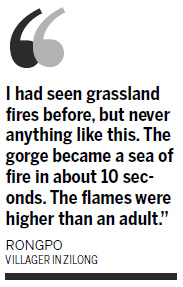Focus
Technology may help save grasslands from fiery wrath
By Huang Zhiling in Sichuan and Jiang Xueqing in Beijing (China Daily)
Updated: 2010-12-09 07:59
 |
Large Medium Small |
|
A man severely injured in last week's Dawu fire receives treatment in a military hospital in Chengdu, capital of Sichuan province, on Monday. Gu Fang / for China Daily |

Dry weather and strong winds combine to turn prairie blazes into "seas of fire" Huang Zhiling in Sichuan and Jiang Xueqing in Beijing report.
Cizi had just returned home from tending his cattle when he saw a fire on the nearby grassland. Frightened, the herdsman attempted to put out the flames with a mop, but fell and injured his right leg.
Using all his strength, he picked himself up and narrowly escaped as a strong gust of wind whipped the flames 40 meters into the air.
His wife, who was in another part of the valley, was not so fortunate.
She was one of 22 people killed by the blaze that raged for almost 24 hours in Dawu, a remote mountainous county in Southwest China's Sichuan province.
The wildfire - the most devastating to the area in decades, say experts - broke out at noon on Sunday and trapped dozens of firefighters and villagers. It was eventually extinguished at 11:10 am the next day.
"I had seen grassland fires before, but never anything like this," said Rongpo (like most ethnic Tibetans, he uses only one name) in Zilong village. He said the memory will haunt him forever.
Police and high-ranking officials are still investigating the cause of the fatal blaze, which scorched 33 hectares of land, according to He Xinghua, an information officer for the Garze Tibetan autonomous prefecture.
Fires are not uncommon on Dawu's 410,000 hectares of natural grasslands, although this time strong winds played a major part in spreading the flames.
Rongpo said he was eating lunch when a neighbor told him there was thick smoke rising from Xiawu Gorge, about 400 meters from his home. He rushed out on his motorbike to investigate before calling the authorities to raise the alarm.
More than 1,000 firefighters, forest workers and soldiers with the Chengdu military region of the People's Liberation Army were on the scene at about 12:40 pm.
The steep-sided gorge is almost inaccessible to vehicles, which meant firefighters could only use portable equipment and rudimentary tools like spades, tree branches and bamboo brooms to stamp out the flames, said Qin Tingqun, head of fire prevention for Dawu's public security bureau.
At about 3:10 pm on Sunday, the blaze was almost out - but just as Rongpo was about to celebrate by inviting his neighbor home for a drink, a gust of wind re-ignited the embers, trapping the duo with several soldiers and forest workers.
"The gorge became a sea of fire in about 10 seconds," he said. "The flames were higher than an adult."
Some of the grass in the gorge was almost 1 meter tall and acted like "a tornado, trapping people", added Zhu Jishuang, an official in Xianshui, the town that administers Zilong. "It was as if the gorge had been immured with gasoline."
Fifteen soldiers, two forest workers and five villagers, including Cizi's wife and the man Rongpo invited to have a drink, died.
Badro, a 51-year-old ethnic Tibetan from Rongpo's village, was among five others who were injured. She suffered burns to 95 percent of her body and is now in a critical condition at People's Provincial Hospital in Sichuan's capital, Chengdu.
As the fire continued to rage on Monday morning, authorities sent 460 more firefighters to help isolate the flames before the arrival of further strong winds, which had been forecast for the afternoon.
Many villagers had spent the night carrying buckets of water from the foot of the mountain to the fire, a four-hour trek. The buckets weighed about 20 kilograms each, said Rongpo.
Seeing the danger
Due to the dry weather in Sichuan, which has one of the largest pastoral areas in China, wildfires are an annual occurrence.
However, this is the first that has resulted in fatalities, said Zeng Zhenggang, a leading official with the Sichuan Grassland Fire Prevention Office who has almost two decades of experience.
Information officer He Xing-hua explained that, each year, local governments in Garze print brochures and notices promoting basic details on fire prevention and firefighting in both Tibetan and Mandarin, distributing them to homes through the grasslands.
Officials also visit villages every winter to give lectures on what to do in emergencies, he added.
Situated in the southeastern swath of the Qinghai-Tibet Plateau, Garze covers an area of 152,600 square kilometers. From a population of 930,500, more than 78 percent are ethnic Tibetan.
In Dawu, which is home to rich forests, grasslands and water resources, about 89 percent of its 49,000 residents are ethnic Tibetan.
The country's early warning fire system is based on weather reports and analysis of the types of inflammable materials in a certain area. Experts argue that the model is not accurate enough and say there is no specific, detailed report on each grassland and forest.
According to the evaluation of its grassland vegetation and meteorology, Dawu is classified as one of the areas most at risk of spontaneous fires in China.
Due to the lack of roads, however, fire trucks cannot get to many of Sichuan's mountainous communities, and firefighters mainly use portable fire extinguishers, which are often criticized for being inefficient.
"More research should be done to develop practical firefighting technologies and methods, as well as portable equipment that is more efficient," said Song Weiguo, a researcher at the State Key Laboratory of Fire Science at the University of Science and Technology.
"With more advanced equipment and professional knowledge, firefighters will be better protected," he said.
In the United States and Canada, airplanes are usually the weapons of choice against wildfires, which has reduced their reliance on manpower.
The US also does a good job with risk evaluation, said Song, who added that the country's authorities send firefighting airplanes to the most endangered areas without wasting time and money.
"Compared to the US and other developed countries, China's evaluation of fire risks lags behind," he said. "We need to improve the accuracy of weather reports and enhance studies on how to classify different kinds of inflammable material."
In addition to funding from the Ministry of Science and Technology, the Chinese government also has a special fund for relevant non-interest scientific studies.
However, further investment is still needed to make rapid improvements, say experts, who also suggest the communication and cooperation between governments and relevant academic institutions should be enhanced.
"We hope to put the results of our research to practice as quickly as possible and receive feedback as soon as they meet problems in the real world," said Song.
He said that communication between his laboratory and officials is not as smooth and intent as it should be.
